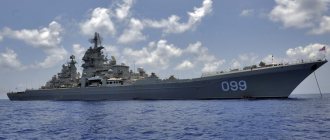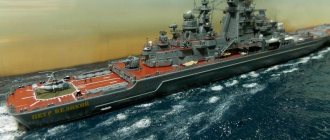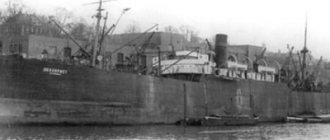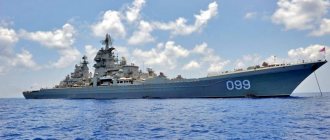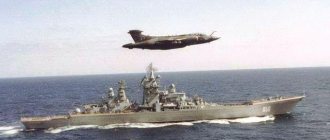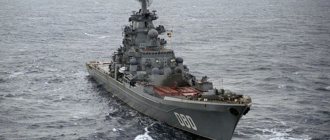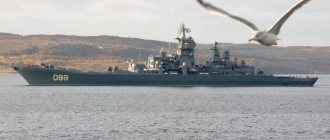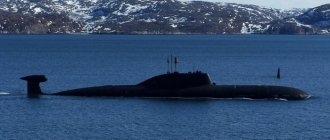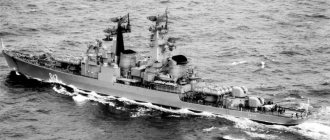The heavy nuclear cruiser “Peter the Great” is rightfully considered the “direct heir” of the famous Soviet artillery battleships and cruisers of the wartime era. The nuclear missile era unconditionally sent them into “retirement.” Against American aircraft carrier armadas and silent nuclear submarines, stuffed with modern electronics and intercontinental ballistic missiles, the main caliber guns were already powerless. On the stocks of the largest Soviet military shipyards, the contours of a new generation of missile-carrying ships were outlined.
Project 1144
The 3rd generation warships (Project 1144) became our response to US naval carrier hegemony. The Soviet Union opposed it with heavy nuclear-powered missile cruisers, which, thanks to their powerful equipment, began to be called “aircraft carrier killers.”
Characteristics
In the period from 1980 to 1998, an “admiral” series of three ships was prepared on the stocks of the Baltic Shipyard - “Admiral Ushakov”, “Admiral Nakhimov”, “Admiral Lazarev”. Its crowning achievement was the heavy nuclear-powered missile cruiser Pyotr Velikiy.
Like his older “brothers”, he is the brainchild of the St. Petersburg Northern Design Bureau. For many years the bureau was headed by Vladimir Evgenievich Yukhnin, under whose leadership Project 1144 was implemented.
General designer of SevPKB V. E. Yukhnin
The laying of the cruiser took place during perestroika times - 1986, which gave way to the “dashing 90s”. It took 12 long years in the conditions of the collapse of the Soviet military-industrial complex, the organizational structure of the Navy and chronic lack of money before, in 1998, “Peter the Great” finally went to its place of permanent service - the Red Banner Northern Fleet.
To emphasize the importance of the Peter the Great as a combat unit of the Russian Navy, it is often called the most powerful attack ship of the “non-aircraft carrier” class. Although this comparison with aircraft carriers in terms of combat power looks very arbitrary, since its main task is the destruction of opposing enemy aircraft carrier orders, which, in addition to the aircraft carrier itself, includes a solid cover. And for this the ship has everything it needs.
The Orlan family
During the Soviet era, it was planned to build 7 cruisers of this type, but only 3 were completed, and later, already in Russia, the 4th was launched. TARK "Kirov" (later - "Admiral Ushakov") and "Frunze" (since 1992 - "Admiral Lazarev") were transferred to the Navy in the early 1980s, but are currently not operational and have been withdrawn from the fleet. The lead ship of the Orlan project was the Kirov, so in the NATO classification such TARKs are called 'Kirov-Class'. Now it is being prepared for disposal, but according to some, there is still hope for the Frunze to be restored, repaired and modernized.
Weapons Russia has created a weapon against swarms of drones
TARK "Admiral Nakhimov" (formerly "Kalinin") has been part of the Northern Fleet since 1988 to this day, although for almost 10 years it has remained under modernization at the Severodvinsk Production Association "". It is promised that it will be equipped with the latest electronics, worthy of the 21st century - we can only hope that this will be the case. However, there are reports that this year the modernization plan has been adjusted, and this protracted process will be completed in the near future.
“Peter the Great” (then it was supposed to be named in honor of the former head of the KGB, and then the General Secretary of the CPSU Central Committee “Yuri Andropov”) was laid down on April 25, 1986, launched 3 years later, but entered into service only in 1998 The well-known difficult situation of the country extended the construction, modification and testing of the ship for 10 years, and its total cost was about 1 billion dollars.
There should be a lot of nuclear cruisers
The impressive dimensions of the nuclear attack missile carrier - 262 x 28.5 m (length, width), with a 59-meter superstructure height and 26,000 tons of displacement - speak volumes. With all this apparent enormity, there is not a single extra square centimeter. The creators of the nuclear attack vessel faced the difficult task of placing and assembling two 300 MW nuclear reactors in a very limited space next to two auxiliary boilers and two 70,000 liter turbines. With. Here it is necessary to add 4 steam turbine generators, 4 gas turbine generators, 4 power plants, a “mountain” of the most modern weapons and more than 700 crew members.
All this gigantic power was translated into a speed of about 60 km/h, a two-month autonomy (for food supplies) and a three-year autonomy for nuclear fuel.
Performance characteristics of the battleship "Peter the Great"
"Peter the Great" in experimental camouflage, Pacific Fleet, 1928. It is in this livery that the battleship will sail to the Baltic, where it will take part in the suppression of the March Putsch. Later, elements of this color scheme would become the standard wartime naval camouflage of the Imperial Russian Navy in all theaters of operations.
| Displacement: | 43,950/48,450 tons |
| Dimensions: | 254.1×35.5×x9.1 m |
| Mechanisms: | 4 shafts, 4 Erikson TZA, 20 Shukhov boilers, 120,000 hp. = 28 knots |
| Fuel capacity: | 1485/3900 tons of oil |
| Range: | 6900 miles (18 knots) |
| Armor: | belt 100–350 mm, traverses 100–375 mm, towers 350–400 mm, tower roofs 200–250 mm, barbettes 250–350 mm, middle deck 25–50 mm, lower deck 100 mm, anti-tank missiles 40+10 mm, deckhouses 250–400 mm, communication pipes 70 mm |
| Weapons: | 12 406/45 mm, 24 130/55 mm guns, 8 75/50 mm anti-aircraft guns, 2 seaplanes |
| Crew: | 46/1296 people |
Another experimental camouflage, Pacific Fleet, 1926. Was an attempt to "reanimate" the standard olive color scheme, which was heavily criticized after the fleet left Port Arthur. Later it will become the basis for the “tropical” painting of ships of the Pacific Fleet.
And one warrior at sea
As you know, American aircraft carriers do not sail alone due to their weak (individual) protection. Cover is provided by 6 to 10 warships (destroyers, guided missile frigates) and up to two nuclear submarines. All together this constitutes an aircraft carrier strike group or order, for the destruction of which the Peter the Great was created.
Launch silos of the Granit complex
To send such an armada to the bottom required a unique weapon, or, using the old “battleship” terminology, the “main caliber”. It was “Granit” - an anti-ship missile system, an outstanding creation of V. N. Chelomey and the team of NPO Mashinostroeniya, which was put into service more than 30 years ago.
For repairs... to Albion!
Until 1878, the engineers of the Berdsk plant tried to correct the technical shortcomings of the power plant, while at the same time the battleship was undergoing combat training, and on July 7, 1878, an accident occurred - the fastening chain of one of the anchors broke, which cost the lives of six sailors.
In addition to such “simple” defects, it was soon discovered that the wear and tear of the power plant left no chance of “bringing it to completion”; this ultimately led to the idea of replacing machines and mechanisms in the UK.
In May 1881, after the conclusion of the relevant agreements, “Peter the Great” set out on its first overseas voyage - I should note that by doing so, the Marine Technical Committee admitted its powerlessness to create a combat-ready ship.
Armament
One can only imagine the consequences of a salvo of 20 Granit cruise missiles weighing 7 tons each, capable of delivering three types of warheads to their destination at a speed of Mach 2.5 over 600 km (depending on the nature of the target) - conventional, nuclear and volumetric.
Moreover, this is not some kind of crowd of flying multi-ton discs, but a “thoughtful” maneuvering, deadly flock flying over the very edge of the water, led by a “leader”. During the flight, "Granites" constantly exchange information and maneuver, which makes them practically invulnerable to enemy shipborne air defense systems.
Dropping deadly "Granites" on the enemy's head, "Peter the First" remains one of the most protected warships. On distant approaches, up to 12 air targets are destroyed by missiles of the S-300F shipborne complex “Reef”, and already on approach the “Blade” and “Dirk” systems enter the battle. The combination of missiles and rapid-fire artillery creates an insurmountable stockade for almost anything that can fly.
Missile and artillery complex Kortik
The naval artillery is represented by AK-130 – twin artillery mounts (cal. 130 mm), “reaching” targets located at a distance of 25 km.
Ka-27 helicopters
The ship is reliably protected from below. It is protected from unwanted encounters with submarines by Ka-27 helicopters, Vodopad missile and torpedo systems, and RBU-12000 and RBU-1000 bomb launchers. It is definitely worth mentioning the effective anti-torpedo system “Udav-1M”. All this operates in combination with a powerful hydroacoustic system that detects underwater targets at medium and low frequencies.
Formidable sea fortress
"Peter the Great" will unpleasantly surprise any enemy, since no surface ship in the world has so many weapons on board. A listing of all the weapons available on board the cruiser, along with technical characteristics, will take more than one page. Below are only the key types of available weapons.
army-news.org
"Granit" - "aircraft carrier killer"
These are anti-ship missile systems, the main weapon of the cruiser. Warheads have both conventional and nuclear warheads. They overcome any missile defense system and destroy a target, regardless of its size and degree of protection. They have artificial intelligence: “fire and forget.” The maximum missile range is 700 km.
"Fort-M" - reactive shield
This is an anti-aircraft missile system. Protects the ship from enemy air attacks - airplanes, cruise missiles. The cruiser is equipped with 12 launchers and 96 vertical launch missiles. Can simultaneously fire at 6 targets in the air and accompany 12.
"Dagger" - anti-aircraft missile system
If an enemy missile passes Fort-M, it will be met by the Kinzhal complex. It repels massive enemy missile and bomb attacks in the near zone. 16 drum launchers are hidden below deck. The anti-aircraft complex detects a target at an altitude of 10 m and a distance of up to 45 km.
“Waterfall” – does the “wet job”
This is an anti-submarine torpedo system. Hit enemy submarines at a distance of up to 60 km. The rocket dives into the water, then when a certain depth is reached, the rocket engine is started, the rocket part is separated, which then flies through the air. Having seen the target, the miniature torpedo dives into the water and attacks the enemy.
"Dirk" - "armor" from high-precision weapons
This is a short-range anti-aircraft artillery complex. Provides protection for the ship from precision weapons, boats, and air vehicles. 6 installations are equipped with a six-barreled gun (total rate of fire - 10 thousand rounds per minute) and 8 missiles.
AK-130 – artillery assistant
A tower artillery complex fires at the enemy at sea and on the shore. The shells weigh 27 kg and are equipped with different types of fuses: impact, remote, radio fuses.
"Boa constrictor" - "eater" of missiles
This is a rocket torpedo defense system. Fires projectiles at different distances, thus forming a barrier line and creating false targets. Hidden at the stern of the cruiser are rocket launchers that fire projectiles to kill.
Electronic means
The ship's air defense system includes Fregat-MAE radar stations with a target detection range and altitude of 300 and 30 km, respectively. General ship tracking facilities include 6 space communication stations (2 SATSOM and 4 SATPAU) and 4 special electronic stations.
"It was a big bummer"
Only on October 3, 1874, the first tests began, during which it became clear that the Hirsch propellers installed on the ship were too susceptible to cavitation, which ultimately determined the need to replace them.
Cavitation is a physical phenomenon that leads to a decrease in pressure and the formation of gas-containing voids in liquid media (in the case of a propeller, when the rotation speed increases and certain indicators are reached, the speed of the vessel does not change and, moreover, may eventually fall when reaching the next so-called second stage , by about 20%).
In July-August 1876, the turrets were mounted and new Griffiths propellers were installed. After the ammunition was loaded, artillery and sea trials began: the first demonstrated satisfactory results, the second, in addition to the fact that the battleship did not produce the calculated power and speed, revealed a number of defects in machines and mechanisms.
Correction of these was entrusted to the manufacturer, so payment to him was delayed. On October 2, 1876, the ship as a whole was declared fit for service.
Links[edit]
- Gardiner, Robert, ed. (1979). All of Conway's World's Warships 1860–1905. Greenwich: Conway Maritime Press. ISBN 0-8317-0302-4.
- McLaughlin, Stephen (2003). Russian and Soviet battleships. Annapolis, MD: Naval Institute Press. ISBN 1-55750-481-4.
- Silverstone, Paul H. (1984). Directory of the World's Capital Ships. New York: Hippocrene Books. ISBN 0-88254-979-0.
- Watts, Anthony J. (1990). Imperial Russian Navy. London: arms and armor. ISBN 0-85368-912-1.
Footnotes [edit]
- "Tower ship PETER THE GREAT (1877) - Imperial Russian Navy". www.navypedia.org
. Retrieved July 27, 2022. - ↑
McLaughlin, pp. 2–4 - ↑
McLaughlin, pp. 4–5 - ^ abcd McLaughlin, page 10
- McLaughlin, page 1
- ↑
McLaughlin, pp. 5–6 - ^ ab McLaughlin, pp. 1, 8
- ↑
McLaughlin, pp. 8–9 - McLaughlin, page 6
- ^ abc Gardiner, page 177
- ↑
McLaughlin, pp. 6–7 - ↑
McLaughlin, pp. 7-8 - Jump up
↑ McLaughlin, pp. 1, 6, 10 - McLaughlin, pp. 153-54
- ^ ab McLaughlin, pp. 154–55
- Watts, page 30
- Silverstone, page 381
- ↑
McLaughlin, pp. 10–11
Mediterranean voyage of "Peter the Great"
By January 23, 1882, all work was completed, and the battleship entered sea trials, demonstrating a speed of 14.4 knots with a power of 8,300 horsepower. A month later, an order was received to proceed to the Mediterranean Sea, where the ship was to become the flagship of the Mediterranean squadron based in Piraeus. He arrived at the port of destination on April 11.
Having visited a number of Italian ports, the squadron moved to Toulon, then returned to Naples, where the Petra was overtaken by an order to return to Kronstadt, where it arrived on August 31, 1882. I would like to draw your attention to the fact that, in essence, his Mediterranean voyage was nothing more than a demonstration of strength.
Service [edit]
"Peter the Great"
built at the state shipyard "Galerny Ostrov" in St. Petersburg. Construction began on June 1, 1869, although her keel was not laid until July 23, 1870. The ship was launched on August 27, 1872 and entered service with the Baltic Fleet on October 14, 1876. It cost a staggering amount - more than five. one and a half million rubles. Two 9-inch mortars were mounted on her quarterdeck during the panic with Britain in the Russo-Turkish War of 1877–1878, but they were removed in 1880, never used in combat. Two Whitehead torpedo launch tubes were added to the ship's sides that same year, but proved ineffective. [13]
Its original equipment turned out to be unsatisfactory, and the Baird plant lost a payment of 254,000 rubles as a fine. The Navy began exploring a replacement vessel in 1878, and a contract was finally signed with John Elder & Co. , in Glasgow, Scotland, in October 1880, based on the favorable experience of the navy with the construction of the company's Imperial yacht Livadia. The ship arrived at the Scottish shipyard only on July 14, 1881 and was refitted until February 1882. New vertical combination steam engines and twelve cylindrical boilers with a working pressure of 70 psi (483 kPa; 5 kgf/cm2) replaced the original defective equipment. The spar torpedoes in the bow were replaced with underwater torpedo tubes for Whitehead torpedoes, and the propellers and rudder were also replaced. Her funnel was also reduced to its original height. February 4, 1882 Peter the Great
carried out sea trials on his new car and achieved a speed of 14.36 knots (26.59 km/h; 16.53 mph) with an engine output of 8,296 horsepower (6,186 kW). The new engine and boilers were slightly lighter than their predecessors, and the ship's displacement was 10,105 long tons (10,267 t). [4]
Immediately after sea trials, the ship departed Scotland for a cruise in the Mediterranean. Peter the Great
visited ports in her at Algiers, Athens, Corfu, Naples, La Spezia and Toulon before being recalled.
She visited Cadiz, Lisbon, Brest and Cherbourg before reaching Kronstadt on 12 September. The ship remained in the Baltic Sea for the rest of her career, her light armament being modified several times. During the 1880s, her rear 4-pounder guns were replaced by two 44-millimeter (1.7 in) Engström guns, and the other two on her bridge were moved to the roof of the forward turret. Peter the Great
's boilers, replaced in 1892, and by the mid-1890s the ship mounted two 4-pounder guns on each turret, six 47-millimeter (1.9 in) 5-drum Hotchkiss rotary guns on the bridge and four 37-pounder guns. mm (1.5 in) Hotchkiss pistols. [4]
Peter the Great
after reconstruction as an artillery training ship
Peter the Great
was considered obsolete by the late 1890s, and a number of proposals were made to renovate it. The most elaborate scheme was to raise the turrets 7 ft 6 in (2.3 m) and build a new armored casemate between the turrets and the deck housing six 6 in (152 mm) guns. The existing 14- and 12-inch wrought iron armor plates will be replaced with Krupp steel plates that are 8 inches (203 mm) and 7 inches (178 mm) thick, respectively. Despite saving 1,000 long tons (1,000 t) by replacing the wrought iron with lighter steel armor, the ship would have gained 674 long tons (685 t) of displacement and her draft would have increased by about 12 inches. This plan was approved, although with very low priority, and her towers were removed in October 1898, but nothing more was done. On June 11, 1903, the head of the Naval Ministry, Admiral F. K. Avelan, ordered that it be converted into an artillery training ship. [14]
The new project was approved on February 2, 1904, although the Baltic Shipyard in St. Petersburg had already begun cutting the ship down to the berth deck. The side armor was removed and a completely new superstructure was built. The boilers were replaced by twelve fire tube boilers, ten refurbished from the Imperial yacht Polar Star and two new. The new boilers only supplied enough steam to give the engines 5,500 designated horsepower (4,100 kW), although a second funnel had to be added to accommodate their exhaust gases. Two masts with battle tops were added. Only the ship's conning tower was now protected by 4 inches (102 mm) of armor plate. [15] Armament was almost completely replaced by four 8-inch 50-caliber guns mounted on barbettes on the upper deck, placed along the sides of the ship, and six 6-inch 45-caliber guns were mounted in unarmored casemates on each side of the ship . [10] The anti-torpedo boat's armament now consisted of twelve 75 mm (3.0 in), four 57 mm (2.2 in), eight 47 mm and two 37 mm guns. [15]
The outbreak of the Russo-Japanese War, almost immediately after its design was approved, meant that work on it slowed to a crawl and only resumed in early 1907. The ship was completed the following year. As a result of reconstruction, the total length of Peter the Great
was 321 ft 10 in (98.09 m), beam 62 ft 4 in (19.0 m), and maximum draft 26 ft 7 in (8.1 m). Her displacement was 9,790 long tons (9,950 t), almost 400 long tons (406 t) lighter than her modified displacement of 10,105 long tons. Its top speed was now 12.9 knots (23.9 km/h; 14.8 mph) and it was carrying 714 long tons (725 t) of coal. This gave a range of 1,500 nautical miles (2,800 km; 1,700 mi).
After its completion, Peter the Great
was assigned to the Artillery Training Detachment until 1917.
[4] A number of sources report that the Soviet Union renamed it Republican
or
Barrikada (Barricade)
, [10] [16] [17] but this is not supported by sources used by McLaughlin after the end of the Cold War.
In the same year it was appointed as a submarine base in Kronstadt and then in Helsinki. Under the Treaty of Brest-Litovsk, the Soviet Union had to evacuate its naval base in Helsinki in March 1918 or have its ships interned by newly independent Finland, even though the Gulf of Finland was still frozen. Peter the Great
reached Kronstadt in April on the so-called "Ice Journey".
On May 21, 1921, the ship was built and used to store mines. It was renamed Blokshiv Nr.
1 December 4, 1923 and ran aground in shallow water due to the autumn flood in September 1923.
She was not refloated or repaired until October 5, 1927. On January 1, 1932 it was renamed Blokshiv Nr.
4 , and on
BS-3
on May 16, 1949, by which time it was already used as a barracks in Kronstadt. The ship was wrecked on April 18, 1959 and subsequently decommissioned. [18]

